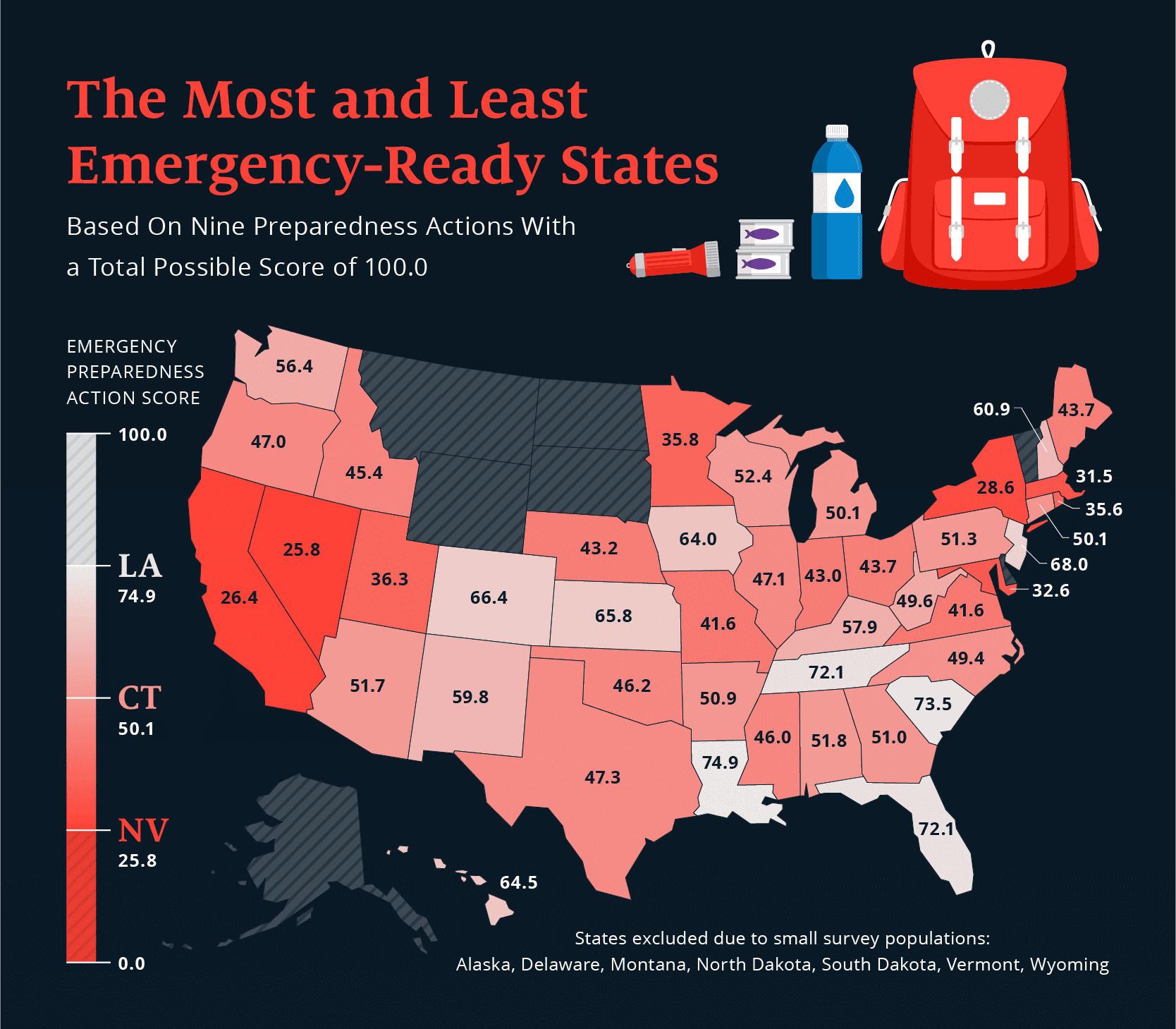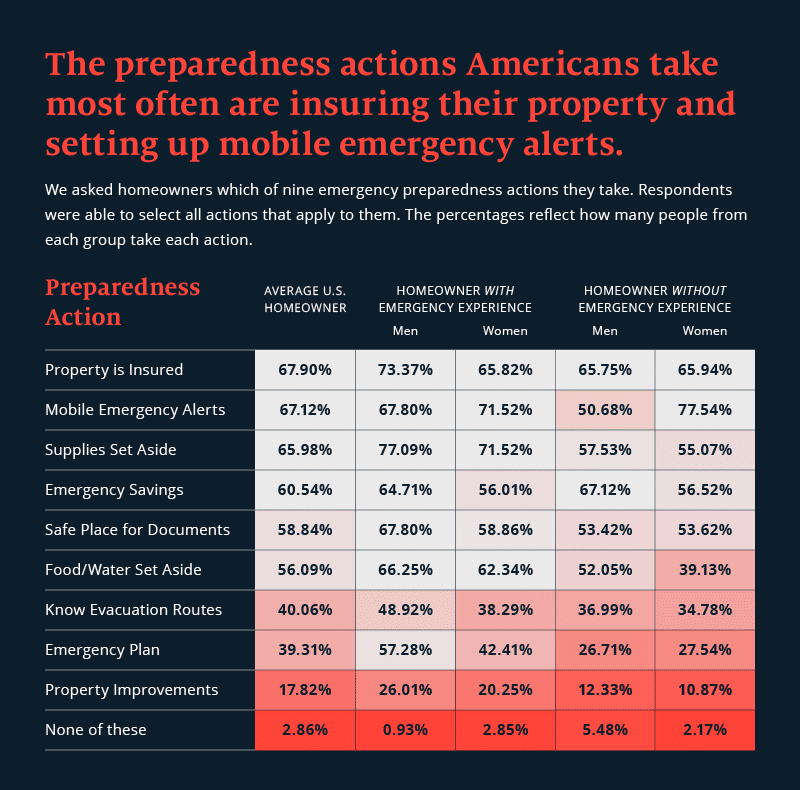Preparing for an emergency is often an afterthought for many Americans until it’s too late. With severe storms and natural disasters seemingly around the corner, we want to shed some light on emergency preparedness by uncovering how ready Americans are for the unexpected.
We asked people with different levels of emergency experience across every state a series of questions to determine how prepared Americans are for a potential disaster. For survey takers, we defined an emergency as any serious, unexpected, or dangerous event that would require you to take immediate action, such as earthquakes, hurricanes, tornados, etc. Read on to see our findings and how your state feels it will fare in the event of a natural disaster.
Which State’s Residents Are the Most Prepared for an Emergency?

The Most Prepared U.S. States
According to our data, Louisiana is the most emergency-prepared state in the U.S., scoring 74.88 out of 100. Following Hurricane Katrina, the state’s flood-protection system was bolstered by $15 billion in federal funds, which strengthened its flood walls and floodgates for future emergencies.
The people of Louisiana also followed suit. A high percentage of residents have emergency supplies on hand, with 76% reporting that they have flashlights, first-aid kits, batteries, and other necessary items. Nearly 80% of Louisiana residents have mobile alerts for emergencies, and 66% have stashed away non-perishable food and water. Over half of the residents (58%) even know their evacuation routes.
South Carolina comes in second place with 73.5 out of 100. Similar to Louisiana, South Carolina is also in a common hurricane and flood area. As a result, a majority of the residents have emergency supplies on hand (74%) and mobile alerts set up (70%). Many South Carolina residents (66%) also have their property insured in case of a weather emergency.
Tennessee follows closely behind with a score of 72.12 out of 100. A significant number of residents (74%) have mobile alerts set up for emergencies, and 72% have emergency supplies set aside. 58% are actively saving in case of an emergency (rainy day fund).
Florida ties with Tennessee for a score of 72.12 out of 100. Florida is another hurricane-prone state, and the data shows that many Floridians take preparation seriously. 78% of residents have emergency supplies, and 66% have mobile alerts set up. 56% of Floridians also have insurance for their properties for weather emergencies.
Additionally, over one-third of respondents (36%) have improved their property to make it more secure against a weather emergency, while 40% know their evacuation routes. However, many Floridians (38%) would opt to stay instead of evacuating during a hurricane.
The Least Prepared U.S. States
Nevada is the least prepared state in the U.S., scoring only 25.75 out of 100. While 60% of Nevadans have emergency supplies on hand, only 38% have their property insured in case of an emergency, and even fewer (36%) have savings to help with the effects of an emergency (rainy day fund). 82% of Nevadans would rather evacuate than stay put if a disaster occurred, second only to Idaho (88%).
California follows closely behind with 26.38 out of 100. Shockingly, only 16% of Californians have an emergency plan, lower than any state in our study. Moreover, only 4% know their evacuation routes, leaving them highly vulnerable during an emergency or natural disaster.
New York also ranks low with a score of 28.58 out of 100. Only 14% of New York respondents have made their property safer to better protect against emergencies, and just 36% have non-perishable food and water put away in case of an emergency.
How Prepared Do Americans Feel?
When it comes to emergency preparedness, there is often a disconnect between how prepared people feel and how prepared they actually are. Our analysis found that in some cases, residents of certain states feel less prepared than they actually are, while in other cases, residents feel more prepared than they really are.
For example, in New Jersey, only 45% of residents feel emergency-prepared, but we found that they are actually the fifth most prepared state in the U.S. On the other hand, states like New York and California are not particularly prepared and know it; only 28% of residents in these states feel ready for an emergency.
While Nevada is the least emergency-prepared state in our study, nearly half (46%) of its residents reported feeling prepared, suggesting that a lack of practical experience and low level of threat may lead to a feeling of preparedness despite limited protection measures actively in place. The most emergency-prepared states sit in common hurricane and flooding areas, while compared to the rest of the United States, Nevada has a low risk of natural disasters.
The Impact Emergency Experience Has On Americans

The impact of emergency experience on Americans’ preparedness actions is another aspect to consider. We found that those with emergency experience are generally more prepared than those without it, particularly when having emergency supplies and non-perishable food and water available. Only about 1 in 4 people without emergency experience have an emergency plan in place, compared to about 50% of those who have been in an emergency before.
We also found that women are more likely than men to have mobile emergency alerts set up, which is their top preparedness action. In contrast, men’s top preparedness action is having their property insured against weather emergencies.
Emergency Preparedness by Gender and Generation

According to our data, men generally feel more prepared than women. The average man believes he could survive 43 days, 18 hours, 49 minutes, and 54 seconds! Meanwhile, women believe they’d run out of time 16 days sooner, at a total of 27 days, 17 hours, 29 minutes, and 52 seconds.
One of the ultimate preparations for an emergency situation — a bunker on your property — varied, not so much by gender but by generation. The desire for an apocalypse-proof shelter is more common in younger generations, and the desire to have a bunker on or under your property decreases with age. The older the respondents, the less likely they were to express interest in having a bunker.
However, we also observed that emergency preparedness tends to increase as people get older. As respondents age, there is a clear and steady rise in the percentage of homeowners who consider themselves emergency-prepared.
Closing Thoughts
In conclusion, our study underscores the importance of emergency preparedness for homeowners. States like New Jersey and Massachusetts ranked high in emergency readiness, while others like California and Nevada take fewer measures to prepare for potential disasters.
At Assurance IQ, we understand the value of being prepared for the unexpected. We help homeowners navigate the complex process of finding and choosing insurance with personalized recommendations and guidance.
We encourage everyone to take emergency preparedness seriously by creating a plan and gathering necessary supplies. Our unbiased, personalized recommendations and guidance help people get the coverage they need to protect what matters.
Methodology
To determine the states where residents are most prepared for an emergency, we surveyed 3,000 respondents across 42 U.S. states over a 2-week period in April 2023. Using data on how many residents take specific preparedness actions, we were able to develop an emergency preparedness score out of 100. States with scores closer to 100 indicate residents who are more prepared for an emergency.
To dig a little deeper, we surveyed homeowners across the country to find out how prepared they are for an emergency with questions about preparedness actions, how their views on emergencies have changed since COVID-10, and how long they could survive if an emergency didn’t allow them to leave their houses.
